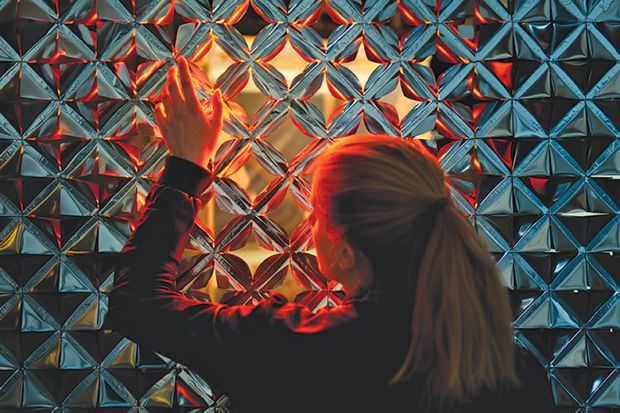Everyone will see the potential of a “smart paint” that monitors the health of the structure it coats. Some will be interested in “Çurface”, a hardwood-like material whose main ingredient is used coffee grounds. Most will be astounded by “aerographene”, a solid whose density is seven times lower than air. These and more than a hundred novel materials or material developments can be found in the latest offering from Blaine Brownell, architect and materials guru from the University of Minnesota.
The first Transmaterial volume appeared in 2006 and rapidly became a sourcebook for architecture students and anyone looking for cutting-edge materials or applications. Transmaterial 2 was published in 2008 and Transmaterial 3 in 2010. This fourth volume follows a similar format to its predecessors. Entries are divided into 10 categories, most of which, such as “concrete” and “metal”, are familiar. Brownell’s decision to claim that “light” and “digital” are classes of material is more adventurous. It is well justified by innovations such as “Starlight Avatar”, said to be the first genetically modified, light-emitting plant.
Every category describes 10 to 12 innovations, and each entry gets two pages. The first page displays colour photographs of the invention. The second provides 150 to 250 words of description, together with brief indications of the material contents of the artefact, its intended application, its environmental impact and where it might be viewed. Limitations and possible future impact are considered, and commercial readiness is assessed on a five-point scale. Contact details for the developer are provided. Each material/invention is claimed to embody one of seven trends: “intelligent”, “multidimensional”, “interfacial”, “recombinant”, “transformational”, “repurposed” and “ultraperforming”.
The 114 products described in the book originate in 18 countries spread over three continents. Not surprisingly given Brownell’s base, 45 come from the US. The UK is well represented with 12, as is the Netherlands. Germany has 16 entries, but no other country manages to achieve more than four, and there are none from France. Germany’s contributions include five from its Fraunhofer Institutes. There are 67 of these spread across Germany (with an offshoot in Glasgow), each concentrating on research in a particular branch of applied science. We have no indigenous UK equivalent, and our new government might do well to ponder this gap in our research provision.
A few of Brownell’s current examples are already at market, but most seem quite a long way from commercialisation. Some, perhaps many, will never make it. It would be a worthwhile research project to look at the success or failure of the innovations described in the earlier Transmaterial books and to identify what the key determining factors were. Brownell argues that the “Next” in his title reflects two timescales. He considers that some of his examples will exert an important influence by 2020, ie, almost immediately. Others, such as the carbohydrate economy and bioengineered materials, are important but will develop only over decades.
You may look to Transmaterial Next as a sourcebook of new professional opportunities. I was simply struck by the breathtaking variety of the materials that now surround us and the boundless ingenuity and inventiveness of those whose work is to create and exploit them.
Richard Joyner is emeritus professor of chemistry, Nottingham Trent University.
Transmaterial Next: A Catalog of Materials That Redefine Our Future
By Blaine Brownell
Princeton Architectural Press, 288pp, £27.99
ISBN 9781616895600
Published 2 May 2017
Register to continue
Why register?
- Registration is free and only takes a moment
- Once registered, you can read 3 articles a month
- Sign up for our newsletter
Subscribe
Or subscribe for unlimited access to:
- Unlimited access to news, views, insights & reviews
- Digital editions
- Digital access to THE’s university and college rankings analysis
Already registered or a current subscriber?




